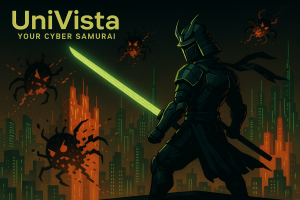
In today’s digital arena, artificial intelligence (AI) is proving to be both a sword and a shield. While AI is revolutionizing the tools we use to defend systems, it is simultaneously equipping cybercriminals with sophisticated means to launch attacks faster and more effectively than ever before. The dual nature of AI is tilting the scales, making cybersecurity harder. Rest assured, with UniVista at your side, your cybersecurity strategy will evolve to protect against the changing landscape.
Is AI Making Cybersecurity Easier or Harder?
UniVista’s stance is clear: AI is complicating cybersecurity. While AI enhanced defense systems show promise, they’re still outpaced by the innovation of threat actors. Here’s why:
- Acceleration of Fake Content Creation: AI tools can generate deceptive emails, synthetic images, and convincing fake personas at scale.
- Lower Entry Bar for Cybercriminals: AI generated scripts and tools make it easier for amateurs to mimic seasoned hackers.
- Outpaced Defenses: The sheer volume and evolving sophistication of threats are overwhelming traditional security systems.
AI Driven Threats: Real World Examples
1. Phishing 2.0: Smarter Social Engineering
Modern phishing attacks now feature AI generated emails that can perfectly mimic a company’s tone, grammar, and branding. These adaptive messages respond to user behavior in real time, increasing the likelihood of deception. AI generated emails mimic human interaction by updating the narrative mid conversation to remain believable.
2. Voice Cloning and Deepfake Audio
In a chilling real world case, a threat actor used AI to impersonate Senator Marco Rubio, sending fake Signal voice messages to high level officials and foreign ministers in a deceptive campaign.
NBC News – AI Voice Used to Impersonate Marco Rubio
3. Synthetic Images and Deepfake Scams
AI generated imagery now plays a central role in digital deception, and it’s not just for funny social media posts:
- Fake LinkedIn Profiles: Cybercriminals use AI headshots to impersonate executives and infiltrate networks.
TechRadar – Fake LinkedIn Profiles - $25.6 Million Deepfake Heist: A finance employee transferred millions after being duped by deepfakes impersonating the company’s CFO during a video call.
CFO.com – $25M Deepfake Scam - Political Misinformation: Deepfakes of figures like Donald Trump and Elizabeth Warren have been used to sway public opinion.
Rigorous Themes – Political Deepfakes
4. AI Powered Malware
AI now enables polymorphic malware, code that rewrites itself on the fly to avoid detection, and adaptive malware that analyzes its environment before executing attacks. AI-driven reconnaissance tools also scan for and prioritize high value targets at unprecedented speed.
5. Automated Exploitation at Scale
AI can now scan and exploit vulnerabilities across massive systems, tailoring each attack based on the specific configuration of the target. This level of automation and customization makes these attacks stealthier and more effective than ever.
The Future of Cybersecurity in an AI Driven World
Cybersecurity has never been a game of static defense, but with AI on the malicious actor’s side, the pace of sophisticated threat detection has increased. To keep pace with AI driven attackers, businesses must:
- Adopt behavior based detection instead of relying solely on signature-based tools.
- Invest in threat intelligence that proactively hunts emerging AI-enhanced threats.
- Continuously train staff, especially in high-risk sectors like finance and government, to recognize and resist AI-driven deception.
How UniVista Is Responding
At UniVista, we’re addressing the AI cybersecurity challenge head on through:
- AI Awareness security strategies
- Investment in advanced threat detection and response tools
- Cybersecurity Awareness Training with KnowBe4: In partnership with industry leaders like KnowBe4, we deliver tailored cybersecurity awareness training that helps employees recognize phishing, deepfakes, and other AI-driven threats. KnowBe4’s platform focuses on managing human risk and building a resilient security culture through continuous education and behavior based reinforcement.
KnowBe4 – Human Risk Management and Security Training - Strategic Partnerships: We collaborate with vendors specializing in AI threat defense, whether through AI augmented platforms or human led threat hunting approaches like those championed by our Cybersecurity partner Huntress Securities.
Conclusion: The Double-Edged Sword of AI
While AI offers powerful tools for defense, it is currently making cybersecurity more difficult due to the speed and sophistication it brings to malicious attacks. Traditional red flags for malicious content are no longer enough to keep your organization safe.
To navigate this new frontier, organizations must stay informed, stay vigilant, and most importantly, partner with cybersecurity leaders like UniVista who are evolving with AI and ensuring customer’s networks are threat resilient.
The future of cybersecurity and AI is about being prepared. Let UniVista be your guide. If you have any questions about this or any other topic we cover, please ask. Your ongoing feedback is always considered as we continue to improve our processes and evolve our offerings.
